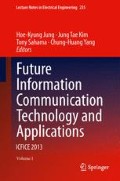Abstract
In this paper, we propose an improved gait identification based on signal collected from mobile sensors (e.g. accelerometer, magnetometer). Based on the observation from previous works, we found that there are restrictions which could negatively affect the efficiency of the system when it is applied in reality. For example the installation error has never been considered well. Additionally, performing identification tasks on mobile devices with limited resource constraints is also a big challenge. In this paper, we propose our own identification method which achieves better accuracy than previous works by taking a deep look at processing steps in gait identification issue. Moreover, the interaction between our identification model and human interaction is improved by minimizing the time delay to perform identification. To do this, the VM-based cloudlet infrastructure is also constructed to perform assigning computation tasks from mobile to nearby powerful PCs that belong to the cloudlet. From initial experiment, the archived accuracy of our identification model was approximately 98.99 % and the response time was reduced by 95.8 %.
Access this chapter
Tax calculation will be finalised at checkout
Purchases are for personal use only
Notes
- 1.
Accessed 13-Dec-2012 at http://kimberley.cs.cmu.edu/wiki
References
Breitinger F et al (2010) User survey on phone security and usage, in BIOSIG, vol. 164GI
Sun H, Yuao T (2012) Curve aligning approach for gait identification based on a wearable sensor. In: Physiological measurement, vol. 33, no. 6
Mondal S, Nandy A, Chakraborty P, Nandi GC (2012) Gait based personal identification system using rotation sensor, In: CIS J 3(3)
Hestbek MR, Nickel C, Busch C (2012) Biometric gait identification for mobile devices using wavelet transform and support vector machines. In: IWSSIP 2012
Yuexiang L, Xiabo W, Feng Q (2011) Gait identification based on acceleration signals of ankle. Chin J Electr 20(3)
Gafurov D, Snekkenes E (2009) Gait identification using wearable motion recording sensors. EURASIP J Adv Signal Proc
Ailisto H et al (2005) Identifying people from gait pattern with accelerometers. In: Proceeding of SPIE 5779, biometric technology for human identification II
Thang HM, Viet VQ, Thuc ND, Choi D (2012) Gait identification using accelerometer on mobile phone. In: ICCAIS 2012
Sprager S, Zazula D (2009) A cumulant-based method for gait identification using accelerometer data with principal component analysis and support vector machine. In: Journal WSEAS transactions on signal processing
Derawi MO et al (2010) Unobtrusive user-identification on mobile phones using biometric gait recognition. In: 6th international conference on IIH-MSP
Holien K (2008) Gait recognition under non-standard circumstances. Gjøvik University College, Master thesis
Pudil P et al (1994) Float search methods in feature selection. In: Patter identification letters 15
Satyanarayanan M (1996) Fundamental challenges in mobile computing. In: Proceedings of ACM symposium principles of distributed computing, p 1
Acknowledgments
This research was supported by Basic Science Research Program through the National Research Foundation of Korea (NRF) funded by the Ministry of Education, Science and Technology (2012-035454).
Author information
Authors and Affiliations
Corresponding author
Editor information
Editors and Affiliations
Rights and permissions
Copyright information
© 2013 Springer Science+Business Media Dordrecht
About this chapter
Cite this chapter
Hoang, T., Vo, V., Luong, C., Do, S., Choi, D. (2013). Improving Cell Phone Based Gait Identification with Optimal Response Time Using Cloudlet Infrastructure. In: Jung, HK., Kim, J., Sahama, T., Yang, CH. (eds) Future Information Communication Technology and Applications. Lecture Notes in Electrical Engineering, vol 235. Springer, Dordrecht. https://doi.org/10.1007/978-94-007-6516-0_12
Download citation
DOI: https://doi.org/10.1007/978-94-007-6516-0_12
Published:
Publisher Name: Springer, Dordrecht
Print ISBN: 978-94-007-6515-3
Online ISBN: 978-94-007-6516-0
eBook Packages: EngineeringEngineering (R0)

